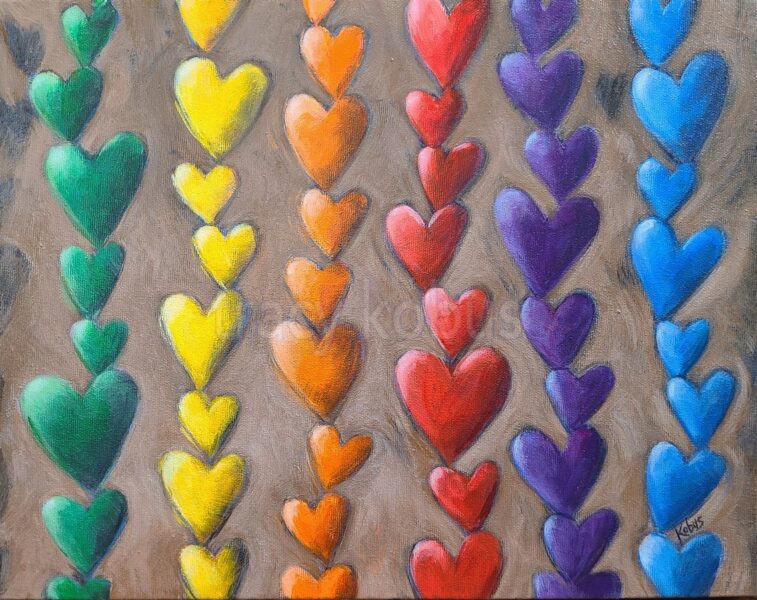How Colour Makes Me Feel

Colour is a power that directly influences the soul, Kandinsky
I’ve often imagined that observing bright colours, especially in nature, was like taking vitamins. The neon green moss in the forest in February, an intense dark blue sky behind white snowy trees, the turquoise blue of a glacial lake or the bright, iridescent shimmer at a hummingbird’s throat have all given me little jolts of well-being, which feel like a boost to my immune system.
In history, people have been inexplicably drawn to pure, bright colours, going to great lengths or paying large sums to acquire pigments for themselves. For example, ultramarine, meaning “beyond the sea”, came from lapis lazuli mined in the remote mountains of Afghanistan. Before this colour was synthetically produced in the mid-18th century, it was as expensive as gold and saved only for the painting of Virgin Mary’s robes or baby Jesus’ garments. Another rare pigment was the brilliant red dye “cochineal” made from crushing parasitic insects of cactus in South America, which after the Spanish conquest, was shipped to Spain in large quantities. Throughout history, many people have died in the pursuit, mining, shipping and acquiring of pure colour.
The paint I use now is made by “Golden” and isn’t (quite) as expensive as gold as it is made synthetically with chemicals. Now we also have cameras in our pockets that can immediately capture colours that we see, sometimes better than our own eyes. We are often using colour editing programs or filters – pretty much everyone has become more adept at seeing and manipulating colour. Even though pigments have lost their rarity and hence, high value in our lives, we are still very drawn by colour.
In the late 1940’s there was an art movement devoted to exploring how colour affected space or our emotions. If you’ve been to a major art museum and seen large canvas’ inexplicably painted with just one or two colours, this may be “colour field” painting. Some painters doing this type of work were Clyfford Still, Barnet Newman or Mark Rothko. The movement was championed by the art critic, Clement Greenberg. Their aim was to surround the viewer with colour, no figure or ground – colour itself was the expression in the painting. Mark Rothko, for example, saw fields of colour as “spiritual planes” that could evoke emotion. (My son says these paintings could be compared to ambient music). I find that after openly staring at a Rothko painting for a minute or two you start to notice that each colour has a role to play; either jump out, recede or let another colour take the lead. If you are in a room of large colour field paintings, even though they aren’t “of” something, each has its own unique personality.
We all feel colour on some level and we can use it to communicate. Bright colours are cheerful and energizing while muted tones convey calmness and stability. Certain colour combinations are soothing, others, called “colour discords” or “clashing” are disturbing and difficult to look at. We surround ourselves with or seek out our “subjective colour”, the colours we like. We may also choose what colour we wear in a day according to how we are feeling, or maybe to help change our mood. Colour has been exploited in advertising, fashion, even fast food restaurants which are often orange and yellow, to stimulate appetites and provide a sense of urgency so we don’t stay long. In nature, colour is important for survival – for finding food or in mating rituals. Many animals see colour differently, such as, fewer select colours or like hummingbirds, can see ultraviolet light and colours we can’t even imagine.
As a painter, I spend my days immersed in mixing pigments together, finding new colour combinations, attempting to capture a certain colour or seeing how it affects composition. You can spend a lifetime discovering secrets about colour. When I see a very bright or especially unexpected colour in nature: a lilac colour sky, a vivid blue shadow in winter, or an arresting orange sunset, they feel like gifts. They take me out of the rut of usual perception, where I know the grass is green and the sky is blue (the natural colour of something in regular daylight, uninfluenced by other colours is known as “local colour”). Anything that helps me feel like I am seeing things for the first time gives me special joy. Colour has this power to captivate and lift you to a higher plane.
Image above: Heart Chains

